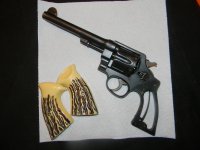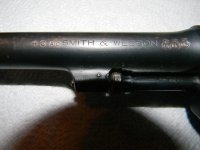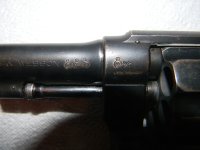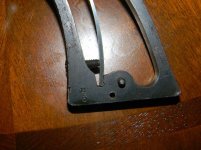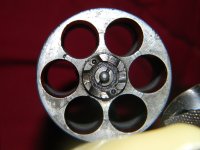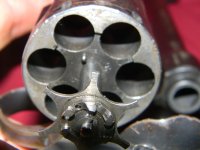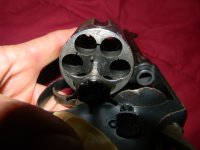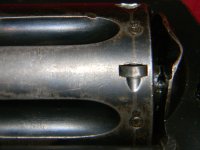Remyshooter
Member
- Joined
- Mar 18, 2012
- Messages
- 11
- Reaction score
- 0
New to the forum. Hello.
Was given a old smith and wesson. Has a bunch of markings on it and I have searched the internet, possibly to my folly. As as I can tell the serial number puts it a 1917 production. However it has two, the one on the barrel is 8xxx, as is the one on butt. On the frame and cylinder arm is 2xxx. Well before the barrel number is the capital letter B, this letter is also behind the shell ejector.
On the top of the barrel is a small cross followed by the SMITH & WESSON SPRINGFIELD MASS. U.S.A PAT'D MAR. 27. 94, (a few more dates, ends with) FEB. 6. 06 then another cross.
Side of barrel 45 AC (no P, no room, see pic) SMITH & WESSON, Followed by three British proof marks, crowns over BV, BP,NP.
Where the barrel meets the frame, crown over BV, crossed swords, under those some words or a long word.
On the side of the cylinder over each chamber are the same brit proof marks, one over each chamber. The only other markings on cylinder are behind the ejector, an E and a 3, and small capital B.
The frame has several other marks. A crown over a T9 with a E under that. However, the stamp didn't take completely, so it was stamped again. Under these II. Not too far from these crossed sword with letters on either side they intersect.
Other side of the frame the s&m trade mark.
Grip frame. E over 3, B over F on other side. Bottom, just serial number, but hole for lanyard loop.
Grips are cheap plastic stag horn look a likes.
I research tells me it is possible civilian model or a gun a solider took home and cleaned of us property marks off, civilian model more likely. British lend Lease kicks in around 1940 and is donated. The Brits test and mark it. Sees some service and makes it's way back to the us with a American soldier for there are no import marks that I could see.
Was given a old smith and wesson. Has a bunch of markings on it and I have searched the internet, possibly to my folly. As as I can tell the serial number puts it a 1917 production. However it has two, the one on the barrel is 8xxx, as is the one on butt. On the frame and cylinder arm is 2xxx. Well before the barrel number is the capital letter B, this letter is also behind the shell ejector.
On the top of the barrel is a small cross followed by the SMITH & WESSON SPRINGFIELD MASS. U.S.A PAT'D MAR. 27. 94, (a few more dates, ends with) FEB. 6. 06 then another cross.
Side of barrel 45 AC (no P, no room, see pic) SMITH & WESSON, Followed by three British proof marks, crowns over BV, BP,NP.
Where the barrel meets the frame, crown over BV, crossed swords, under those some words or a long word.
On the side of the cylinder over each chamber are the same brit proof marks, one over each chamber. The only other markings on cylinder are behind the ejector, an E and a 3, and small capital B.
The frame has several other marks. A crown over a T9 with a E under that. However, the stamp didn't take completely, so it was stamped again. Under these II. Not too far from these crossed sword with letters on either side they intersect.
Other side of the frame the s&m trade mark.
Grip frame. E over 3, B over F on other side. Bottom, just serial number, but hole for lanyard loop.
Grips are cheap plastic stag horn look a likes.
I research tells me it is possible civilian model or a gun a solider took home and cleaned of us property marks off, civilian model more likely. British lend Lease kicks in around 1940 and is donated. The Brits test and mark it. Sees some service and makes it's way back to the us with a American soldier for there are no import marks that I could see.

